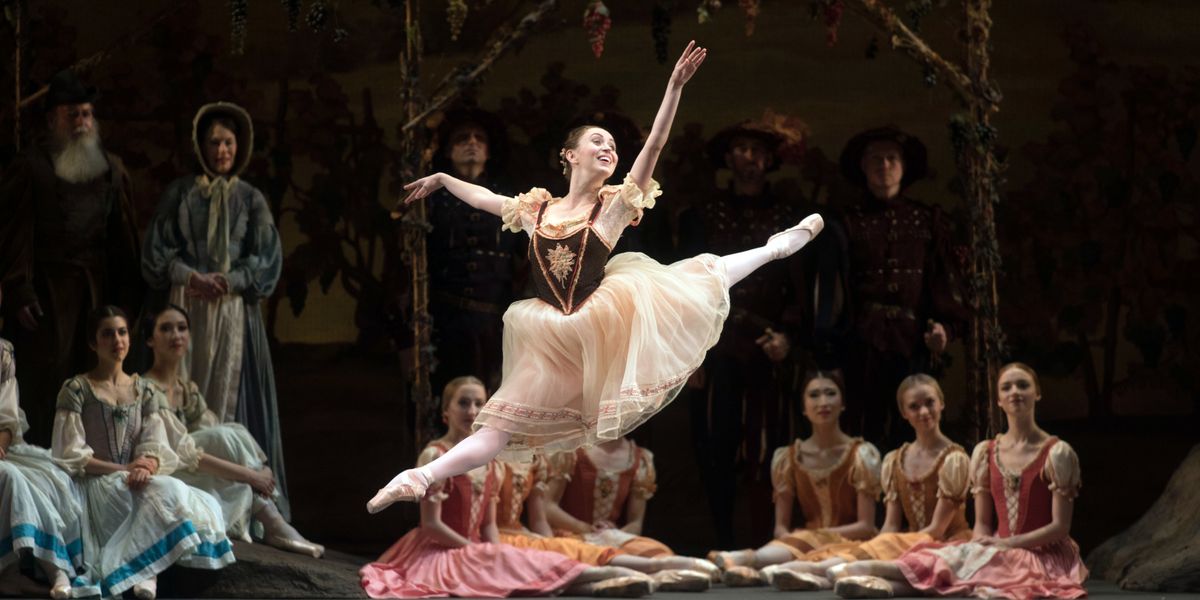Defining and Refining Musicality: How to Tune In and Develop Your Artistic Voice
Ask a hundred people what musicality is, and you’re likely to get a hundred different answers. “Musicality is where an artist’s personality shines brightest,” says Smuin Contemporary Ballet member Ben Needham-Wood. For American Ballet Theatre soloist Skylar Brandt, “it’s what distinguishes one dancer from another. It helps me express myself more vividly and emotionally.”
Teachers encourage it, directors seek it out and dancers who possess it bring choreography to life in compelling ways. But what exactly is musicality, and how can dancers get more of it?
Putting Musicality Into Words

Musicality could be loosely described as a dancer’s unique emotional and intellectual relationship to a piece of music, as expressed in their execution of choreography. “I connect musicality to rhythm, phrasing, tonality and mood—all these elements that allow the body to inhabit music from the inside out,” says Atlanta Ballet choreographer in residence Claudia Schreier.
Comparing two dancers in the same role can help make it clearer, says David Morse, a Cincinnati Ballet soloist, choreographer and class accompanist. He cites Royal Ballet principals Natalia Osipova and Marianela Nuñez in the Black Swan variation as a good example. “Natalia has this punch behind everything,” he says. “When she goes from Point A to Point B, there’s power on the front end and then a suspend. With Marianela, there is an airiness in arriving at the next position, more like a sustain across the beat. They could not be more different, in large part due to those small increases and decreases in speed.”

Claudia Schreier rehearses her ballet Passage with Dance Theatre of Harlem. Rachel Neville, Courtesy Schreier
Most of those choices are made in rehearsal, but sometimes they reflect a dancer’s spontaneity. Miami City Ballet principal soloist Lauren Fadeley remembers feeling caught off guard when MCB’s orchestra played unexpectedly slowly during Balanchine’s La Valse. “But our rehearsal pianist came up to me afterward and said, ‘That was one of the most musical performances of that ballet I’ve ever seen,'” says Fadeley. “You have to listen to the music and just dance. And enjoy it—that’s what will really shine through.”
These examples demonstrate a deeply personal element that each dancer can find within themselves. “The dancers we look up to are the ones who bring their true selves to every step through their musicality,” says Schreier. “What we really get drawn to is that freedom. And that comes from exploring their relationship to the music and falling in love with it in their own way.”
The Building Blocks

Ben Needham-Wood and Terez Dean in Amy Seiwert’s Renaissance. Chris Hardy, Courtesy Smuin Ballet
Paradoxically, dancers reach that level of musical freedom through deliberate, dedicated practice. “It has to start from barre,” says Brandt, who describes herself as “rigid” about doing combinations at the ballet master’s prescribed tempos because “it trains your body to handle the demands of a faster dégagé than you’re used to, or a slower adagio, when you get onstage.” Having so much command over her musicality, she says, “makes me feel like I can get lost in what I’m doing—like I can be an embodiment of the music, versus the music being a separate entity.” On the other hand, deliberately playing with the rhythms and patterns at barre can lead to equally important insights, says Brandt.
A basic understanding of music can be an inroad into greater self-expression. Fadeley, for instance, grew up playing piano and flute. Her ability to read music and quickly grasp time signatures has been critical to mastering the Balanchine oeuvre. “You can have a Stravinsky score that is so hard to count—there’s a 13 and a 9 and an 11,” she says, referring to the complex time signatures found in many Balanchine works. “Even in the ‘Waltz of the Snowflakes’ in The Nutcracker, there’s a part where we would count a 12 or a 13 after counting 8s.”
Take advantage of free online resources, like MusicTheory.net, Signals Music Studio’s YouTube demos and WikiHow.com’s section on reading music, to familiarize yourself with time signatures, concepts like tempo and phrasing, and forms like sonata and minuet. Along with entry points into the score a choreographer has chosen, that understanding can provide anchors for your interpretation of their choreography. “You might have your counts on 1 and 2 and 3,” says Needham-Wood, “but how you play with all those little ‘ands’ is how your musicality comes out.”
As empowering as those building blocks are, the most compelling artists infuse their musical knowledge and technical mastery with something innate and, yes, undefinable. “When musicality is really in your body, you’re not thinking about it. It just happens because you are letting yourself move,” says Schreier.
Be Your Own Maestro

Lauren Fadeley and Chase Swatosh in Balanchine’s The Four Temperaments. Alexander Iziliaev, Courtesy MCB
Dancing at home is ideal for exploring your own sense of musicality and artistic voice, because you can turn off the Zoom camera and take some risks, free of any feedback but your own sense of what feels authentic. “This is not about proving anything to anyone. This is about taking an opportunity to discover what you’re able to do,” says Needham-Wood.
Ready to get started? These exercises can help you discover insights and artistry that you’ll bring back to the studio and the stage.
Reorchestrate the barre:
Barre is a great place to experiment with your musicality, says Brandt. “Play with your phrasing, play with your accent. Hold your fifth position a millisecond longer than you would have. Really differentiate your tendus that are accent out from tendus that are accent in. We should all be doing that anyway, so that by the time we arrive at rehearsal or a performance, we have musicality in our bodies.”
Push the boundaries:
“Make up a piece of choreography, and dance it to the same music three times,” says Schreier. “Try to do it exactly on the music, then just behind the music, and then just ahead. How does that change your physicality? How does it change your relationship to the music? Which one feels best for you? What can you pull out of the silences?”
Bust a new move:
“If you only expose yourself to one approach to musicality, you’re limiting your potential to express yourself,” says Needham-Wood, who also teaches hip hop. Try tap, Broadway, or popping and locking. “Ballet is often about the melody, while contemporary brings in more percussive sound, and hip hop has a sense of weight to it. The more you allow yourself to get outside of your comfort zone, the more your comfort zone will grow.”
Experiment with time signatures:
A time signature is a notation used in Western music to indicate the number of rhythmic beats in a measure of music—the ones most familiar to dancers are 4/4 (think of the steady 1-2-3-4 of tendus en croix) and 3/4, which is waltz time. Composers use time signatures to create effects in their music, from strident tension to a cascading sense of joy—if you’re dancing to agitated music by Stravinsky, for example, you might encounter 3/32, 4/16, 11/4, while in a pop ballet set to the Beatles’ “Here Comes the Sun” you’ll find 11/8, 4/4 and 7/8.
A great way to build a sense of time signatures is to experience them for yourself. ABT principal conductor Charles Barker suggests listening to the nationalistic dances in Sleeping Beauty or Swan Lake, and hearing the time signatures of the mazurka, polonaise and waltz. “Listen to it, then move to it and feel how all the phrases are not all the same tempo.” Try the third movement of Brahms’ Symphony No. 3, which is in 3/8 time, or the second movement of Tchaikovsky’s Symphony No. 6, in 5/4. “Tchaikovsky has lots of music in 5/4. Play with it! He was playing with it, so we should as well.”






